|
Forest & Shade Tree – Insect & Disease Conditions for Maine April 15, 2021
Hello, we’ve launched our new website, and we’re pleased to introduce a new look to our newsletters. Check out the new website at https://www.maine.gov/dacf/. Note that you may need to clear the browser cache.
In this issue:
This is the first Conditions Report for the 2021 season. As spring seems to be moving ahead a bit faster than usual, scout for the usual suspect forest pests a bit earlier rather than depending on the calendar. Also, keep an eye out for the new forest health issues threatening Maine’s forest resources. As always, please reach out with concerns or observations about forest health through our on-line reporting form or by calling (207) 287-2431. You can also use our new general email address foresthealth@maine.gov.
The Maine Forest Service (MFS) Forest Health and Monitoring Division thanks you for your continued interest in and contributions to these reports. We value your participation as a critical part of the forest health monitoring network and wish you a healthy and safe growing season. This year, we ask for your patience with slow responses to inquiries. We are currently short two critical staff members due to temporary leave and new employment.
Office hours are 7:30 am to 4:00 pm, Monday through Friday, except for holidays. However, we are currently working remotely and DACF buildings are closed to public access. Status of the building closure will be updated on the DACF homepage, www.maine.gov/dacf.
Aron Bishop was promoted to Entomology Field and Mapping Supervisor in December 2020. This position coordinates Forest Inventory and Analysis (FIA) Unit activities. Aron started in a Conservation Aide position with the FIA unit in 2001 and in 2008 was promoted to an Entomology Technician position.
James Canwell joined our FIA unit in early March as a Conservation Aide in southern Maine. James transferred from the Department of Marine Resources.
Jordan Downs was promoted to Entomology Technician in our FIA Unit in Waterville, ME. Jordan began working in the unit as a Conservation Aide in December 2019 and has quickly become proficient in the work.
Regina Smith, Entomology Technician, left employment with the Insect and Disease Management unit to work for the Cooperative Forest Research Unit at the University of Maine in March. We will miss her able presence in southern Maine and look forward to seeing the outputs of her work in her new position. One of the recent projects Regina worked on was the videos produced for this year’s Agricultural Trades Show. If you haven’t had a chance to see them, please check them out on the Maine Forest Service YouTube Trades Show Playlist.
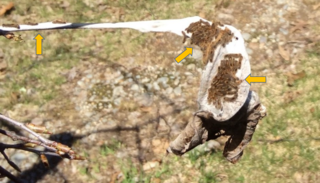
Browntail moth (Euproctis chrysorrhoea)
Image: Browntail moth caterpillars emerging from their winter web.
The annual winter web survey, like many things this year, was a bit more complicated due to restrictions on the number of staff per vehicle. However, the survey wrapped up a couple of weeks ago and our staff has produced a new map in a format which moves away from the risk maps of previous years. The new format displays the raw winter web survey data points underlain by the aerial defoliation and damage polygons from last season (2020). Field staff detected webs in Aroostook County (Fort Fairfield, Monticello and Smyrna) for the first time in many years. This speaks to the ability of this species to hitch-hike rides on vehicles as the caterpillars, pupae and adults will all take a free ride when they get the chance.
BTM caterpillars are already emerging from their winter webs in Southern Maine to feed on the buds and newly emerging leaves of host trees. This emergence marks the end for the best opportunity to clip webs since the caterpillars will be out and the risk of being impacted by their toxic hair will be higher. However, with careful attention to precautions, there is still an opportunity to remove and destroy low webs.
|
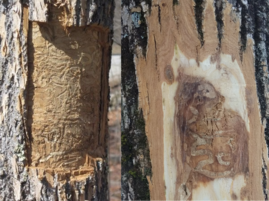
Emerald ash borer (Agrilus planipennis)
Image: (left) EAB galleries revealed by removing a section of bark, E. Tewksbury; (right) A close-up of EAB galleries.
Since our last conditions report in 2020, we have discovered new populations of emerald ash borer (EAB) in Maine. An extensive network of girdled trap trees throughout northern Maine in 2020 led to the discovery of EAB in Grand Isle, Frenchville and Van Buren (new town) in Aroostook County. It appears that the spread of EAB in northern Maine is still relatively slow compared to southern Maine, possibly partly due to the colder climate, and to the fact that this is a smaller point-source infestation.
In southern Maine the infestation is spreading more quickly. The peeling of girdled trap trees in 2020 led to discoveries of further EAB in Portland and the first EAB in Gorham and South Berwick. All other new discoveries of EAB have been by MFS personnel and landowners noticing woodpecker feeding, as well as bark splitting and epicormic growth. This visual monitoring has led to the finding of EAB in Cornish, Parsonsfield, Shapleigh, Newfield, York, and Waterboro in York County, Westbrook and Saco in Cumberland County, and Porter, the first find in Oxford County. The most recent EAB discovery by a landowner in Cornish is not yet on the map.
We greatly appreciate all the reports we receive from landowners of woodpecker feeding on ash. Externally, it is often not possible to determine whether a woodpecker is feeding on EAB or some native woodborer taking advantage of stressed ash trees. If you see woodpecker feeding and are able to peel back the bark with a tool like a hatchet or draw knife, or if you can chip out a section of bark with a hammer and chisel, exposing any insect feeding tracks or galleries below the bark, we may be able to tell from an image whether the damage is EAB or other.
|
 Image: Known location and quarantine boundaries for emerald ash borer (EAB) in the Portland area and in Maine.
Ground Nesting Bees
Reports of ground nesting bees are already coming in. Solitary ground-dwelling bees nest colonially. When they first emerge in early spring, they are usually very active: flying, mating, exploring and nest-building. As people increase their yard-work activities, they begin to notice the bees. All this activity by bees can look frightening. However, solitary bees (one nest for each female, although you may have many nests in one area) are generally non-aggressive and will not sting unless severely harassed. The males can often act very aggressive while they fly around searching for a mate, but they can’t sting at all. This heightened activity persists for only a week or two, and then the bees are almost unnoticeable. Ground nesting bees are valuable pollinators.
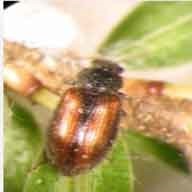
Hemlock woolly adelgid (Adelges tsugae)
Image: Female Laricobius osakensis on hemlock. USDA-FS
Spring is here, and that means that hemlock woolly adelgid (HWA) is at its most easily transmitted stage. From late March until August, all it takes to start a new infestation is for one egg or one mobile crawler to be transferred to a new tree. If you wish to prune any low-hanging branches to reduce accidental movement of crawlers during the spring and summer, leave the cut branches at the base of the tree or in your woods. Very few crawlers will be able to climb back into the tree. Now is not the time to throw potentially infested hemlock branches into the back of your truck and drive down the road, leaving tiny crawlers blowing in your wake. If possible, wait until September to do major work in your hemlock trees or to move branches with foliage.
We have encouraging news about biological control of HWA. Over the years we have released many predators of HWA. Earlier this month MFS personnel met with Joe Elkinton, a researcher at the University of Massachusetts, to provide him with some research sites. With unexpectedly warm weather, we collected specimens of all three species of HWA predators released in previous years: Sasajiscymnus tsugae, Laricobius nigrinus and L. osakensis. We not only found these predators at the sites where they were released, but also at sites up to three miles away. This indicates that these predators are well-established, multiplying, and spreading to new areas where HWA is present. Although we cannot say with certainty how much of an impact they are having on HWA populations or whether this will be enough to save hemlock trees, we suspect they are slowing the mortality of hemlocks in Southern Maine.
|
Spruce budworm (Choristoneura fumiferana)
Now that the final data for 2020 are available, another season of spruce budworm (SBW) monitoring in Maine is finally under our belts as we already begin to plan and get organized for the upcoming 2021 season. While we did not capture the numbers of moths in 2020 that we recovered in 2019, signs still point towards the fact that SBW populations remain above endemic lows heading into 2021. Most notably, a greater number of overwintering SBW larvae were recovered this past season as branch samples were processed throughout the winter months, increasing the likelihood that SBW larval feeding damage will become more apparent on the landscape. As always, we’ll be keeping a close eye on this forest pest this season through our various monitoring methods and will keep our readers up to date on the latest SBW happenings. For more information on the 2020 SBW monitoring season and full results, the complete program report is available at DigitalMaine.com
New MFS Insect & Disease Lab survey for 2021
Maine will once again be participating in the Early Detection and Rapid Response survey in 2021, funded in part by the US Forest Service. This survey focuses on non-native bark and ambrosia beetles that pose a serious threat to Maine’s forests. Maine was part of the EDRR pilot project, and last participated in this survey in 2009. During the pilot, 22 states participated and in addition to many new state records being identified, five non-native beetle species new to North America were identified. After this initial success, the survey has gained national traction and many states continued to participate every year. Maine has re-joined the ranks because a new spot became available. Each EDRR site consists of three funnel traps baited with specific pheromones and attractants to determine whether any of the target bark and ambrosia beetle species are present in high-risk areas. Twelve trap sites have already been installed in early April in time to capture any of the earliest flying species on the target species list and the trapping area spans western to central Maine ranging from Bethel to Pittsfield. The traps will be monitored for a total of 12 weeks and come down in early July. All samples will be sent to identifiers with the US Forest service and we’ll keep our fingers crossed they don’t find anything of concern.
European larch canker eradication (Lachnellula willkommii)
The European larch canker (ELC) is an exotic canker fungus that causes cankers on the branches and main stem of larch trees. Thankfully, the fungus is only present in some areas of Downeast and coastal Maine that are currently under quarantine due to presence of the disease and are subject to yearly monitoring. However, there is one outlier population of larch trees infested with the canker in Brunswick, Maine. The MFS, in cooperation with the landowner, has been working toward eradication of the canker in the area for several years. This has included yearly survey of all the larch trees in the area and providing recommendations for pruning or removal. For the past two years, MFS have been assisting with pruning work. In early April 2021, MFS staff pruned 43 cankers from roughly 70 trees. The most positive development in this cooperative effort has been the landowner’s removal of larch trees based on MFS recommendations. In the past year, roughly 40 trees have been removed, a steep increase from previous years’ removal numbers. More larch tree removals are planned this spring based on the 2021 survey. Cooperative work to eradicate ELC in this area will continue in 2022.
Images: (left) MFS staff record ELC survey data and (right) prune out ELC cankers.
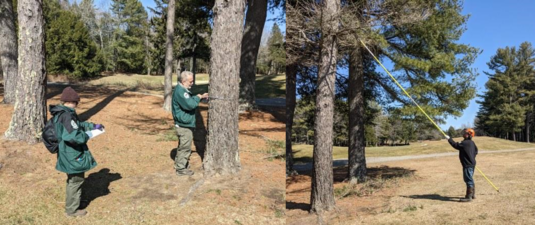
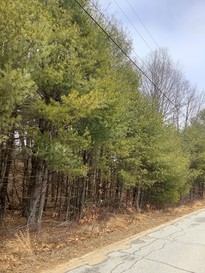
Late winter off-color white pines
Image: Late season dull coloration of white pine. Wayne Searles, MFS.
While it is not unusual for some conifers to lose some degree of their green color during late winter, a greater degree of dull coloration and yellowing white pine foliage was reported throughout southwestern Maine in February and March. These symptoms are not due to the white pine needle cast diseases, as the timing is too early for the associated symptoms. Further, reports described symptoms throughout the entire crown rather than the bottom two thirds of the crown, which would be typical of needle disease symptoms. Thus, in the absence of salt exposure (which, unlike the phenomenon described here, usually results in orange discoloration; see section on Salt damage to roadside trees) the yellowing is presumably due to natural processes, possibly influenced by a combination of genetics, environmental conditions and soils. There were a handful of observations of yellowing white pines in central Maine at this same time on lighter (sandier) soils. While both areas experienced drought conditions during a large portion of spring and summer 2020, perhaps drought and soil are influencing factors. Whatever the reason, pines are expected to regain their green color later in spring when the trees become more physiologically active. If pines do not regain their color, more serious problems may exist such as root disease or environmental chlorosis, a condition where trees are not able to absorb sufficient levels of iron from the soil. While root disease is untreatable for a tree in any setting, chlorosis (describing yellowing symptoms throughout the crown) in landscape trees in horticultural settings can be addressed with soil amendments containing chelated iron, a form of iron trees are able to absorb more easily.
|
Mammal damage to trees
There have been several late winter reports of squirrels stripping the bark off of maples in Central and Northern Maine – and this is likely occurring across the state. One offered explanation for this is the increased sugar content of the inner bark at this time of year in trees like maples, basswood and elms. Also, squirrel damage may be worse/more common this year due to the early summer drought of 2020, which may have caused trees to produce less seeds and nuts, limiting the squirrels’ food sources (i.e. hungrier than normal squirrels selecting less preferred food sources). Porcupine feeding may be more noticeable this time of year as well.
If you do not witness the creature in the act of stripping bark, there are ways to distinguish between the two based on teeth marks and bark strip size. Teeth marks smaller than 1/8 inch are typical of squirrels, while porcupine teeth marks are closer to 1/4 inch. Keep in mind, voles also are known to eat the bark of trees and shrubs, but this damage is usually located close to the ground, or even under the ground or mulch layer.
To discourage voles from girdling your trees, make sure you use tree guards through the winter months and don’t use too thick of a mulch layer to discourage burrowing. To discourage squirrels and porcupines, install a sheet of smooth tin/metal around the trunk of the tree roughly three feet from the ground surface. This will only be effective if the affected tree is isolated and not in a clump of trees where squirrels and porcupines can climb a neighboring tree to access the tree on which they wish to feed. As these animals tend to favor a specific tree, discouraging feeding may cause the animals to pick their second favorite tree in your yard, increasing the number of impacted trees.
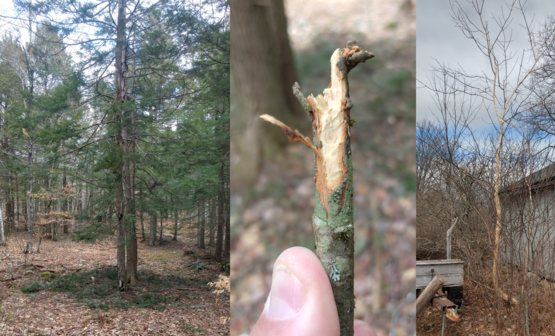 Images: (left) A hemlock tree with close to 30% 0f its branches clipped off, presumably by a porcupine; (middle) the larger teeth marks indicative of porcupine damage; (right) bark chewed off a boxelder by squirrels, almost from top to bottom.
Pruning storm-damaged trees
Trees in many areas of Maine sustained storm damage as a result of the several strong wind storms of winter 2020 and 2021. Pruning damaged limbs will help the tree recover from the injury, and can also reduce the hazard to people and property that can result from falling limbs, however timing is key. Pruning is best done in late winter, when the threat of disease spread is lowest. Early spring is often not an appropriate time to accomplish pruning tasks for two important reasons: pruning when sap is running to supply new buds the materials for leaf expansion is a drain on tree resources; and pruning during the time of an actively growing cambium, the tissue that is producing new wood and bark for the coming year, can result in excessive bark tearing and significant additional injury to pruned trees. Especially for maples (including boxelder), birch, ironwood (Ostrya virginiana), musclewood (Carpinus caroliniana), black walnut and butternut, wait until the leaves have fully expanded (July) before tackling pruning tasks. Keep in mind that dead wood can be safely pruned at any time of the year following correct and safe pruning practices. For guidance on pruning, refer to the USFS Tree Owner’s Manual.
Salt damage to roadside trees
Consistent with most years, orangish conifer foliage was witnessed and reported along roadsides across Maine this late winter. The reason for this is damage from de-icing products used on roadways. Salts are aerosolized and deposited on roadside trees leading to tissue desiccation. While the damage to conifers is apparent soon after exposure, the damage to deciduous trees may not be seen until budbreak. Salts can enter twigs through leaf scars and buds may be killed or damaged. Salt damage is often only severe on the road-facing side of trees. If salt run-off concentrates in the soil low-lying areas with tree growth, more severe and full-tree symptoms are observed and may result in severe decline and tree mortality.
 Images: (top) Roadside salt damage to conifers on Highway 295; (left) Salt damaged hemlock needles; (middle) Salt damaged balsam fir tree; (right) A close-up of salt damaged balsam fir needles.
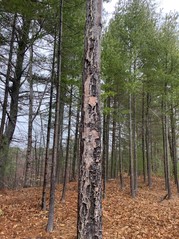
Sunscald
Image: Sunscald injury to a white pine tree adjacent to a recently cleared area. Wayne Searles, MFS
Reports of burn-like symptoms were reported in a few spots in Maine this late winter, but this injury, typically on the south side of trees, is common throughout Maine. Thin-barked trees are more susceptible to sunscald than thicker-barked trees and some species tend to sunscald easier than others. Symptoms are especially noticed in exposed areas, like among trees in parking lots. The sun-scalded white pine pictured here was adjacent to an area cleared last year – the trees along this new edge were not adapted to exposure to direct sunlight and suffered significant damage. Sunscald injuries may allow the entry of fungal pathogens that cause cankers or decay or make affected trees attractive to secondary pests.
|
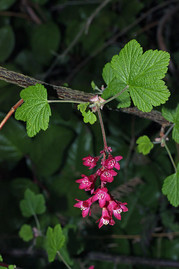
White pine blister rust (Cronartium ribicola)
Image: A member of the genus Ribes, a currant plant, one of several species in this genus which can serve as the primary host for white pine blister rust. USFS
Plants in the genu Ribes are the primary hosts of white pine blister rust caused by the fungus C. ribicola. Many Ribes plants, like currants and gooseberries leaf-out early and are now actively expanding their leaves in Southern Maine. Because foliage of most other forest vegetation has not yet emerged, early spring is an ideal time to scout for Ribes plants. Located plants can be treated now (physically removed or treated with herbicide), or “flagged” for treatment at a later date. Removal of all Ribes species within 900 – 1000 feet of susceptible pines or pine stands will provide acceptable protection from white pine blister rust.
|
Details of upcoming events can be found by visiting the MFS events calendar.
Conditions Report No. 1, 2021
View on-line
Department of Agriculture Conservation & Forestry
Maine Forest Service – Forest Health and Monitoring
Contributors: Aaron Bergdahl, Allison Kanoti, Greg Miller, Mike Parisio, Thomas Schmeelk and Colleen Teerling
Unless otherwise noted, photos by Maine Forest Service, Forest Health and Monitoring, DACF
|